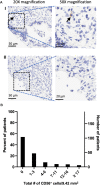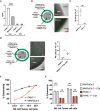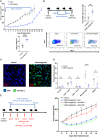The Combination of Radiotherapy and Complement C3a Inhibition Potentiates Natural Killer cell Functions Against Pancreatic Cancer
- PMID: 35937458
- PMCID: PMC9354534
- DOI: 10.1158/2767-9764.crc-22-0069
The Combination of Radiotherapy and Complement C3a Inhibition Potentiates Natural Killer cell Functions Against Pancreatic Cancer
Abstract
Pancreatic cancer is one of the deadliest cancers, against which current immunotherapy strategies are not effective. Herein, we analyzed the immune cell composition of the tumor microenvironment of pancreatic cancer samples in The Cancer Genome Atlas and found that the presence of intratumoral NK cells correlates with survival. Subsequent analysis also indicated that NK cell exclusion from the microenvironment is found in a high percentage of clinical pancreatic cancers and in preclinical models of pancreatic cancer. Mechanistically, NK cell exclusion is regulated in part by complement C3a and its receptor signaling. Inhibition of the C3a receptor enhances NK cell infiltration in syngeneic mouse models of pancreatic cancer resulting in tumor growth delay. However, tumor growth inhibition mediated by NK cells is not sufficient alone for complete tumor regression, but is potentiated when combined with radiation therapy. Our findings indicate that although C3a inhibition is a promising approach to enhance NK cell-based immunotherapy against pancreatic cancer, its combination with radiation therapy hold greater therapeutic benefit.
Conflict of interest statement
M.M. Olcina reports grants from Medical Research Council Unit Grant and Cancer Research UK Oxford Centre during the conduct of the study. Q.-T. Le reports non-financial support from Merck; personal fees from Nanobiotix, Roche, and Coherus outside the submitted work. A.J. Giaccia reports grants from NCI and ASCO during the conduct of the study. No disclosures were reported by the other authors.
Figures






Similar articles
-
DPP inhibition alters the CXCR3 axis and enhances NK and CD8+ T cell infiltration to improve anti-PD1 efficacy in murine models of pancreatic ductal adenocarcinoma.J Immunother Cancer. 2021 Nov;9(11):e002837. doi: 10.1136/jitc-2021-002837. J Immunother Cancer. 2021. PMID: 34737215 Free PMC article.
-
C3aR Signaling Inhibits NK-cell Infiltration into the Tumor Microenvironment in Mouse Models.Cancer Immunol Res. 2022 Feb;10(2):245-258. doi: 10.1158/2326-6066.CIR-21-0435. Epub 2021 Nov 24. Cancer Immunol Res. 2022. PMID: 34819308 Free PMC article.
-
Inhibition of Cbl-b restores effector functions of human intratumoral NK cells.J Immunother Cancer. 2024 Nov 17;12(11):e009860. doi: 10.1136/jitc-2024-009860. J Immunother Cancer. 2024. PMID: 39551607 Free PMC article.
-
Natural Killer Cells in Cancers of Respiratory System and Their Applications in Therapeutic Approaches.Immun Inflamm Dis. 2024 Nov;12(11):e70079. doi: 10.1002/iid3.70079. Immun Inflamm Dis. 2024. PMID: 39588940 Free PMC article. Review.
-
NK cells shape pancreatic and oral tumor microenvironments; role in inhibition of tumor growth and metastasis.Semin Cancer Biol. 2018 Dec;53:178-188. doi: 10.1016/j.semcancer.2018.08.001. Epub 2018 Aug 3. Semin Cancer Biol. 2018. PMID: 30081230 Review.
Cited by
-
The role of the complement system in the response to cytotoxic therapy.Semin Immunol. 2025 Mar;77:101927. doi: 10.1016/j.smim.2024.101927. Epub 2025 Jan 6. Semin Immunol. 2025. PMID: 39765018 Free PMC article. Review.
-
A guide to complement biology, pathology and therapeutic opportunity.Nat Rev Immunol. 2024 Feb;24(2):118-141. doi: 10.1038/s41577-023-00926-1. Epub 2023 Sep 5. Nat Rev Immunol. 2024. PMID: 37670180 Review.
-
Complement activation at the interface between adipocytes and cancer cells drives tumor progression.JCI Insight. 2025 Feb 18;10(6):e184935. doi: 10.1172/jci.insight.184935. JCI Insight. 2025. PMID: 39964754 Free PMC article.
-
The complement C3a/C3aR pathway is associated with treatment resistance to gemcitabine-based neoadjuvant therapy in pancreatic cancer.Comput Struct Biotechnol J. 2024 Oct 5;23:3634-3650. doi: 10.1016/j.csbj.2024.09.032. eCollection 2024 Dec. Comput Struct Biotechnol J. 2024. PMID: 39469671 Free PMC article.
-
Hypoxia-induced complement component 3 promotes aggressive tumor growth in the glioblastoma microenvironment.JCI Insight. 2024 Aug 22;9(19):e179854. doi: 10.1172/jci.insight.179854. JCI Insight. 2024. PMID: 39172519 Free PMC article.
References
-
- Siegel RL, Miller KD, Fuchs HE, Jemal A. Cancer statistics, 2021. CA Cancer J Clin 2021;71:7–33. - PubMed
-
- Rahib L, Smith BD, Aizenberg R, Rosenzweig AB, Fleshman JM, Matrisian LM. Projecting cancer incidence and deaths to 2030: the unexpected burden of thyroid, liver, and pancreas cancers in the United States. Cancer Res 2014;74:2913–21. - PubMed
-
- Sung H, Ferlay J, Siegel RL, Laversanne M, Soerjomataram I, Jemal A, et al. . Global Cancer Statistics 2020: GLOBOCAN estimates of incidence and mortality worldwide for 36 cancers in 185 countries. CA Cancer J Clin 2021;71:209–49. - PubMed
-
- Pourshams A, Sepanlou SG, Ikuta KS, Bisignano C, Safiri S, Roshandel G, et al. . The global, regional, and national burden of pancreatic cancer and its attributable risk factors in 195 countries and territories, 1990–2017: a systematic analysis for the Global Burden of Disease Study 2017. Lancet Gastroenterol Hepatol 2019;4:934–47. - PMC - PubMed
-
- Huang J, Lok V, Ngai CH, Zhang L, Yuan J, Lao XQ, et al. . Worldwide burden of, risk factors for, and trends in pancreatic cancer. Gastroenterology 2021;160:744–54. - PubMed
Publication types
MeSH terms
Substances
Grants and funding
LinkOut - more resources
Full Text Sources
Medical

